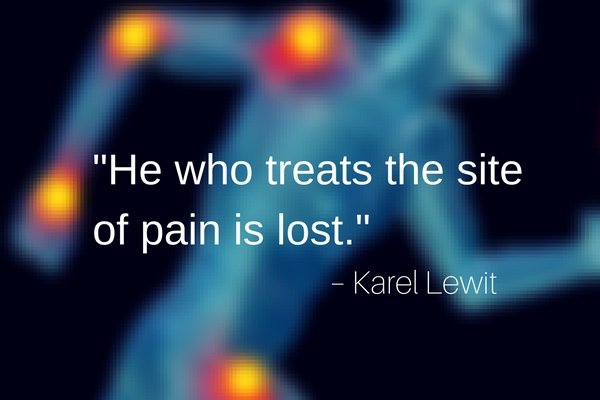Chronic pain is often a result of muscle imbalances. These occur when muscles that work together to either stabilize or move a joint have imbalances in their length and strength. For example, sitting encourages the shoulders to move forward relative to your spine.
To achieve this, the anterior muscles such as the pectoralis major, minor, and anterior deltoid must contract. As a result of this contraction, the opposing (or antagonist) muscles that include the rhomboids, middle trapezius, and the posterior deltoid must lengthen.
One side contracts and the other lengthens. Pretty simple. Now what happens when this position is held for long periods of time or frequently...or both?

Over time, the contracting muscles become "facilitated", which simply means that they've gotten very good of shortening to that position. In turn, the muscles that are lengthened typically become inhibited. Although they're having to work a little harder in a lengthened position, they can lose strength over time.
Muscle imbalances and postural distortions lead to a limited joint range of motion, impingement issues, energy inefficiency, and chronic pain over time.
The First Step
The first step to addressing this common issue is to identify your muscle imbalances and weaknesses. A skilled manual therapist (e.g., St. John's Neurosomatic Therapist, CHEK Practitioner, Osteopath, etc.) can test and assess your muscles and joint mobility.
They can help you determine which muscles are working more than they should, and which ones are weak and require strengthening.
You'll also need to identify any postural imbalances. The following are some common postural issues:
- Forward head posture
- Rounded shoulders
- Excessive spinal curvature
- Torsion of the pelvis
These signs indicate muscle imbalances and other issues.
Action Steps
Short facilitated muscles must be lengthened using whatever flexibility strategy works best. Static, dynamic, PNF are stretching methods that can be used. Manual therapies can also be highly effective (if not essential) in restoring muscle balances.
Long and weak muscles must be strengthed using isometric and dynamic exercises. Begin by strengthening the core muscles through a properly designed exercise program that addresses the abdominal, back, pelvic floor, spinal, and breathing muscles.
Your movements should vary and the variables related to your exercise program (sets, repetitions, rest periods, etc.) should be changed over time give your body the necessary stimulus for progress.
Use exercises that result in flexion, extension, and rotation of the joints in the body. The fundamental goal is to increase strength, mobility, and function of the whole you.
Finally, you can balance the 6 foundational principles that were taught to me by Paul Chek at the Chek Institute. The following are the basic anchors on which your health foundation is built. Use them to continually assess and address to maintain optimal health and wellness:
- Thinking
- Breathing
- Movement
- Nutrition
- Hydration
- Sleep
This is a basic introduction to the ways in which muscle imbalances contribute to dysfunction and pain. Identifying your muscle imbalances helps you create a plan to correct them. Along with managing the 6 foundation principles of health, restoring balance to your physical body is critical to long-term wellness and pain-free living.
Contact:@darwinruiz_
I'm going to shamelessly plug the Feldenkrais Method of Somatic Education. For me, the best part about this method is the approach that each individual body is different, and the practitioner will help the client learn what is best for their body. There is no prescribed ideal posture, etc., just what is ideal in YOUR body. And through learning about it (as opposed to the practitioner simply "fixing" your body), you ultimately have more control to change your patterns.
YES! I'm a big fan of the Feldenkrais Method. I recommend it! It's such a great way to improve neuromuscular function while becoming more aware of your movements. Thanks for the reminder!
I'm a Guild Certified Practitioner myself, and I it makes my heart so happy when someone knows of the Method! You just made my day. Thanks, stranger! :)
I couldn't help myself. I just posted an introduction to the Feldenkrais Method: (https://steemit.com/academia/@jeska/the-feldenkrais-method-of-somatic-education-an-introduction) Thanks for inspiring me! :)
Yes...I saw that. I tried to reply to your question about where I experienced Feldenkrais (I was introduced to it through the CHEK Institute and did some classes when I lived in San Francisco). For some reason, I was getting an error message when I tried to post my reply.
In any case, great read. Thanks for the info.